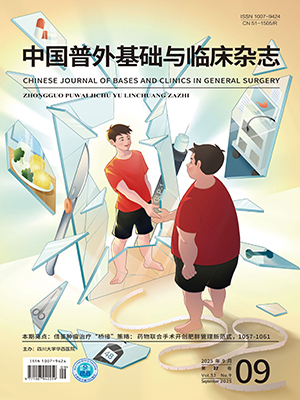| 1. |
姚刚, 曹峻, 谷昊, 等. 腹腔镜与开腹肝切除术比较治疗肝癌的 Meta 分析. 中国循证医学杂志, 2013, 13(5): 588-595.
|
| 2. |
Reich H, McGlynn F, DeCaprio J, et al. Laparoscopic excision of benign liver lesions. Obstet Gynecol, 1991, 78(5 Pt 2): 956-958.
|
| 3. |
许大彬. 中国大陆腹腔镜肝切除术发展历史及现状. 腹腔镜外科杂志, 2016, 21(9): 714-716.
|
| 4. |
Yin Z, Fan X, Ye H, et al. Short- and long-term outcomes after laparoscopic and open hepatectomy for hepatocellular carcinoma: a global systematic review and meta-analysis. Ann Surg Oncol, 2013, 20(4): 1203-1215.
|
| 5. |
刘荣, 黄志强, 周宁新, 等. 腹腔镜肝切除术的手术入路探讨. 中华医学杂志, 2004, 84(3): 219-221.
|
| 6. |
原发性肝癌诊疗规范 (2017 年版). 中国实用外科杂志, 2017, 37(7): 705-720.
|
| 7. |
董家鸿, 黄志强. 精准肝切除—21 世纪肝脏外科新理念. 中华外科杂志, 2009, 47(21): 1601-1605.
|
| 8. |
方驰华, 方兆山, 范应方, 等. 三维可视化、3D 打印及 3D 腹腔镜在肝肿瘤外科诊治中的应用. 南方医科大学学报, 2015, 35(5): 639-645.
|
| 9. |
张传泽. 基于三维重建技术的肝体积和结构评估在肝切除术中的应用. 中国医药科学, 2018, 8(11): 243-245, 253.
|
| 10. |
李刚. CT 三维重建技术在精准肝切除手术规划的研究. 昆明: 昆明医科大学, 2016.
|
| 11. |
张绍祥, 姜洪池, 梁力建, 等. 计算机辅助联合吲哚菁绿分子荧光影像技术在肝脏肿瘤诊断和手术导航中的应用专家共识. 中国实用外科杂志, 2017, 37(5): 531-538.
|
| 12. |
邵贤, 贾乃昕, 陈佳慧, 等. 应用三维重建及虚拟肝切除系统的腹腔镜下精准切除右肝肿瘤. 中华普通外科杂志, 2016, 31(7): 538-540.
|
| 13. |
贾萌. 三维重建技术联合腹腔镜精准肝切除术治疗原发性肝癌的临床疗效观察. 肝胆外科杂志, 2017, 25(2): 115-117, 122.
|
| 14. |
范应方, 向飞, 蔡伟, 等. 基于三维可视化技术的右半肝门静脉 3D 分型及分段. 南方医科大学学报, 2016, 36(1): 26-31.
|
| 15. |
周显军, 董蒨, 朱呈瞻, 等. 数字化重建技术在基于肝脏门静脉结构的肝段划分中的作用及意义. 中华外科杂志, 2018, 56(1): 61-67.
|
| 16. |
Tranchart H, Di Giuro G, Lainas P, et al. Laparoscopic liver resection with selective prior vascular control. Am J Surg, 2013, 205(1): 8-14.
|
| 17. |
Cai X, Li Z, Zhang Y, et al. Laparoscopic liver resection and the learning curve: a 14-year, single-center experience. Surg Endosc, 2014, 28(4): 1334-1341.
|
| 18. |
陈智远, 韦玮, 郭荣平, 等. 大肝癌切除术中输血与患者预后关系的探讨. 中国肿瘤临床, 2010, 37(8): 457-460, 466.
|
| 19. |
张朋飞, 于松宁, 雷鹏, 等. 3D 打印技术在精准肝切除术前评估的应用. 中国普通外科杂志, 2017, 26(7): 831-837.
|
| 20. |
王壮雄, 李林容, 王芳元, 等. 虚拟和增强现实技术在肝脏外科中的应用. 实用医学杂志, 2018, 34(7): 1210-1212.
|
| 21. |
Yang T, Tan T, Yang J, et al. The impact of using three-dimensional printed liver models for patient education. J Int Med Res, 2018, 46(4): 1570-1578.
|
| 22. |
周伟平, 李鹏鹏. 三维可视化技术基础上的肝癌切除—精准与个性化的结合. 中国实用外科杂志, 2018, 38(4): 378-380.
|
| 23. |
董家鸿, 郑树森, 陈孝平, 等. 肝切除术前肝脏储备功能评估的专家共识 (2011 版). 中华消化外科杂志, 2011, 10(1): 20-25.
|
| 24. |
Mise Y, Sakamoto Y, Ishizawa T, et al. A worldwide survey of the current daily practice in liver surgery. Liver Cancer, 2013, 2(1): 55-66.
|
| 25. |
Cai W, Fan Y, Hu H, et al. Postoperative liver volume was accurately predicted by a medical image three dimensional visualization system in hepatectomy for liver cancer. Surg Oncol, 2017, 26(2): 188-194.
|
| 26. |
Zhang J, Qiao QL, Guo XC, et al. Application of three-dimensional visualization technique in preoperative planning of progressive hilar cholangiocarcinoma. Am J Transl Res, 2018, 10(6): 1730-1735.
|
| 27. |
Mise Y, Satou S, Shindoh J, et al. Three-dimensional volumetry in 107 normal livers reveals clinically relevant inter-segment variation in size. HPB (Oxford), 2014, 16(5): 439-447.
|
| 28. |
Hallet J, Gayet B, Tsung A, et al. Systematic review of the use of pre-operative simulation and navigation for hepatectomy: current status and future perspectives. J Hepatobiliary Pancreat Sci, 2015, 22(5): 353-362.
|
| 29. |
Zhao D, Lau WY, Zhou W, et al. Impact of three-dimensional visualization technology on surgical strategies in complex hepatic cancer. Biosci Trends, 2018, 12(5): 476-483.
|
| 30. |
Gruttadauria S, Vasta F, Minervini MI, et al. Significance of the effective remnant liver volume in major hepatectomies. Am Surg, 2005, 71(3): 235-240.
|
| 31. |
李连海, 王建伟, 刘斌, 等. 三维重建在肝切除术前评估中的临床应用效果. 临床肝胆病杂志, 2016, 32(5): 938-941.
|
| 32. |
Takamoto T, Hashimoto T, Ogata S, et al. Planning of anatomical liver segmentectomy and subsegmentectomy with 3-dimensional simulation software. Am J Surg, 2013, 206(4): 530-538.
|
| 33. |
项楠, 方驰华, 范应方, 等. 三维可视化技术联合 3D 腹腔镜在肝胆外科的应用. 中华消化外科杂志, 2014, 13(4): 306-309.
|
| 34. |
方驰华, 张文宇, 杨剑. 三维可视化联合 3D 腹腔镜右半肝切除术的关键技术和优势. 中华普外科手术学杂志: 电子版, 2017, 11(5): 364-367.
|
| 35. |
Oshiro Y, Yano H, Mitani J, et al. Novel 3-dimensional virtual hepatectomy simulation combined with real-time deformation. World J Gastroenterol, 2015, 21(34): 9982-9992.
|
| 36. |
Oshiro Y, Ohkohchi N. Three-dimensional liver surgery simulation: computer-assisted surgical planning with three-dimensional simulation software and three-dimensional printing. Tissue Eng Part A, 2017, 23(11-12): 474-480.
|
| 37. |
Aoki T, Murakami M, Koizumi T, et al. Three-dimensional virtual endoscopy for laparoscopic and thoracoscopic liver resection. J Am Coll Surg, 2015, 221(2): e21-e26.
|
| 38. |
Kingham TP, Jayaraman S, Clements LW, et al. Evolution of image-guided liver surgery: transition from open to laparoscopic procedures. J Gastrointest Surg, 2013, 17(7): 1274-1282.
|
| 39. |
Peterlík I, Courtecuisse H, Rohling R, et al. Fast elastic registration of soft tissues under large deformations. Med Image Anal, 2018, 45: 24-40.
|
| 40. |
Lv A, Li Y, Qian HG, et al. Precise navigation of the surgical plane with intraoperative real-time virtual sonography and 3D simulation in liver resection. J Gastrointest Surg, 2018, 22(10): 1814-1818.
|




